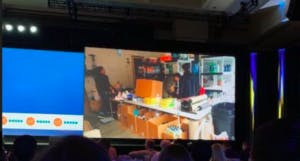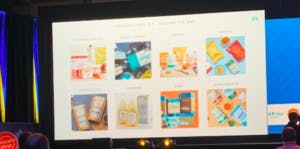I recently spoke at Groceryshop 2018 in Las Vegas, and it was a whirlwind of conversations and information on innovation, thought leadership, and exciting developments in the grocery industry. I’ve already shared with you two of the four key trends and takeaways I found; here are the third and fourth important insights I learned.

3. Retailers are focused on U.S. online grocery penetration and growth
The U.S. has a relatively low penetration of online grocery shopping — only 1 to 2% as compared to the UK’s approximately 8%, according to Ocada’s presentation at Groceryshop 2018. But the online grocery market is set to quadruple by 2023 — the wheels are in motion, and if retailers aren’t planning for it, they’re going to be left behind.
Three companies have been making waves in online grocery shopping, and they’re ones to watch — or continue watching — as this new channel widens:
Instacart has successfully reached 70% U.S. household penetration (they’re targeting 80%) and has close to 300 retail partners.
 Boxed is hitting its stride with club value packs and convenience. While value used to be focused solely on money, now it’s focused on a combination of convenience, price, and brand/quality. This company has come a long way since starting in the bedroom of a suburban New Jersey neighborhood — now they’ve got fully automated picking facilities, and attribute much of their success to their automation and smaller SKU count for easy selection and large basket sizes.
Boxed is hitting its stride with club value packs and convenience. While value used to be focused solely on money, now it’s focused on a combination of convenience, price, and brand/quality. This company has come a long way since starting in the bedroom of a suburban New Jersey neighborhood — now they’ve got fully automated picking facilities, and attribute much of their success to their automation and smaller SKU count for easy selection and large basket sizes.
Ocada, the largest online grocery retailer in the UK, has dispelled the following myths about online groceries:

- No one makes money selling groceries online (Untrue — they are proof that it is possible to penetrate online discovery and make money doing it)
- No one buys fresh online (Untrue — fresh participation for Ocada is 48%)
- Online grocery is a niche market for Millennials (Untrue — 50% of UK online groceries are sold to families)
The company custom built their technology solutions and have a sophisticated robotics warehouse and dispatch, making Ocada considerably cheaper for the customer. Picking orders takes 15 seconds, compared to the 1.14 hours of a store/manual picker. They have partnered exclusively with Kroger in the U.S.
4. Purpose-led or transparent brands are leaders
From the retail perspective, buyers are looking for trending, innovative, transparent, purpose-led brands with a real story to help them differentiate and succeed in today’s climate.
Today’s consumers need to know what a product stands for and what a brand is doing socially and environmentally for the greater good of the world. Private label brands have shifted from necessity products to premium, natural/organic, and even sometimes purpose-led products. These are not staple items — they are differentiated offerings that bring customers back into the store. Transparency is the key! Here are just a few examples of companies that are setting an industry standard for this new requirement:

Thrive Market, for example, is one of the leading e-commerce health retailers, and for every
subscription purchased the company gives a six-month subscription to a low-income household to make health accessible for all.
Ollie is a direct-to-consumer dog food company that focuses on ingredient transparency and uses human food for dogs to help canine pals lead healthier lives.
Koia, a 100% plant protein drink, uses simple ingredients to deliver unparalleled nutrition.
The grocery retail industry is in constant motion these days, with innovation, new products, and new technologies making big waves. The future of grocery change is here, and both retailers and suppliers are embracing these changes — and many more to come.
